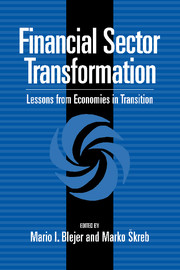Book contents
- Frontmatter
- Contents
- List of Contributors
- Introduction: Financial Reforms and Economic Transition: An Overview of the Major Issues
- PART I GENERAL STUDIES
- PART II COUNTRY STUDIES
- 5 Banking Crises in the Baltic States: Causes, Solutions, and Lessons
- 6 Monetary and Exchange Rate Policy, Capital Inflows, and the Structure of the Banking System in Croatia
- 7 Monetary and Financial Market Reform in Transition Economies: The Special Case of China
- 8 The Financial Sector and High Interest Rates: Lessons from Slovenia
- 9 Bank Rehabilitation in Slovenia: With Emphasis on Nova Ljubljanska Banka
- 10 Liberalization and Financial Reforms: Lessons from the Israeli Experience
- PART III AFTERWORD
- Index
8 - The Financial Sector and High Interest Rates: Lessons from Slovenia
Published online by Cambridge University Press: 05 November 2011
- Frontmatter
- Contents
- List of Contributors
- Introduction: Financial Reforms and Economic Transition: An Overview of the Major Issues
- PART I GENERAL STUDIES
- PART II COUNTRY STUDIES
- 5 Banking Crises in the Baltic States: Causes, Solutions, and Lessons
- 6 Monetary and Exchange Rate Policy, Capital Inflows, and the Structure of the Banking System in Croatia
- 7 Monetary and Financial Market Reform in Transition Economies: The Special Case of China
- 8 The Financial Sector and High Interest Rates: Lessons from Slovenia
- 9 Bank Rehabilitation in Slovenia: With Emphasis on Nova Ljubljanska Banka
- 10 Liberalization and Financial Reforms: Lessons from the Israeli Experience
- PART III AFTERWORD
- Index
Summary
In October 1991, Slovenia launched its new currency. High inflation was immediately attacked by drawing money out of the economy. Stabilization policy was implemented with restrictive monetary policy and fiscal policy of a balanced budget. Stabilization policy went hand in hand with a restructuring of the real and financial sectors and permanent sterilization efforts. In addition to a wholesale reshaping of the economy, a voucher system of privatization was introduced.
Stabilization resulted in a steady calming inflation. By the end of 1995, it had dropped to around 0.7 percent per month. The economy started to pick up; after the first two years of stabilization, it started to grow at around 4 percent per year. The economy ran high surpluses in current account till 1995; afterward current account balance became negligible. Foreign-exchange reserves increased even more because of significant inflows of foreign capital. The policy makers were mostly concerned by pressure from costs of wages and interest rates; those costs were high permanently. Wages increased over 29 percent in real terms (GDP only 12%) to 1996, while interest rates started to fall from the level of around 15 percent for real lending interest rates only after the first half of 1994. Stubbornly high real interest rates are known in other stabilization episodes. In Chile, for example, interest rates soared in real terms to over 48 percent per year during the financial liberalization period; in Israel, the marginal real interest rate attained over 35 percent, on average, during the first two years of stabilization. Rocketing of real interest rates was especially pro- nounced in the economies where stabilization was combined with massive deregulation and the opening of the financial sector.
- Type
- Chapter
- Information
- Financial Sector TransformationLessons from Economies in Transition, pp. 309 - 333Publisher: Cambridge University PressPrint publication year: 1999

